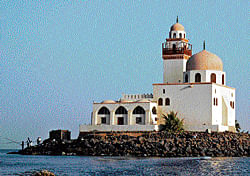With Haj slated for the last week of October, pilgrims have already started to converge in Makkah (and Madina), the focal point for Haj.

Makkah does not have an airport and Jeddah, Kingdom of Saudi Arabia’s commercial capital, serves as a gateway to Makkah.
Majority land up in Jeddah (and some in Madina) in order to take this pilgrimage. Even during the days when journeys were taken through seas, pilgrims from all over the world used the Jeddah port to go to Makkah.
I had an opportunity to live in Jeddah for one year, between 2000-2001. I have fond memories of the ancient city, whose city walls were built during the Mameluke era, when Sultan Alghouri of Egypt ruled, around 1509AD.
When I visited the sprawling city again in June this year, these memories came flooding back. Though many glitzy malls have made its entry into this expansive city, the place has retained its traditional charm.
“Praise be to god, who has made the port of Jiddah the best of ports,” wrote the famous chronicler Ahmad ibn Faraj in his 16th-century history of this native city. In any mention of Jeddah, Balad is the first subject that instantly comes to mind.
Al-Balad is the soul of Jeddah, where the city as we know it now originates. The area is a warren of alleys replete with exquisite heritage buildings, with awe-inspiring wooden lattice balconies, and a plethora new businesses, cafes etc.
A walk through the old city in Balad takes one back to the city’s yesteryears. Large town houses with artistic bay windows called rawashin, a Persian word meaning ‘splendid and bright’, are a feast for the eyes. Built on corbels or timbers jutting out from the walls, these gingerbread units traditionally varied in quality and number, according to the builder’s capacity.
The cynosure of the area is the Naseef House, which has since been restored in the 1990s and now accommodates a cultural centre. The house used to belong to the deputy wali (ruler) of Jeddah, Mohammad Nassif, but is now owned by the Jeddah Municipality. Nassif House has 15 rooms on seven floors and was erected about 150 years ago.
The chief trading port of the Red Sea, Jeddah has a well-developed corniche about 75kms in length. A good part of the corniche is bustling with visitors and the local municipality has provided superb recreational and picnicking facilities.
Little wonder you will find locals and other Arabs relaxing on chairs, smoking the sheesha, while others are engaged in barbeque and watching football on TVs on the beach. Adults wishing to indulge in water sports can hire jet skis and sailboats. Among the major attraction on the corniche stretch is the world famous 312 m high King Fahd Fountain.
A single massive plume of water reaches higher than the Eiffel Tower! Another sight that catches one’s eye is the corniche mosque which juts into the water, giving a feeling that it is floating in the Red Sea.
Yet another aspect of Jeddah is that the whole of the city is emblazoned with a glittering collection of sculptures that dot the city landscape. In fact, these monuments, numbering about 350, do the job of a compass, as it guides people to locate their destinations. Some of the well-known sculptures include the bicycle, which stands tall at an astonishing 15 m, a seagull, an engineering compass, an illuminated globe, obelisks, mosque lanterns, a plane in the clouds, sailing ships, Islamic calligraphy etc.
The city is home to very old mosques. The oldest mosque in the city is Al-Shafei Mosque, and was built of teak brought from Sudan, situated in Harrat Al-Mazloum in Souk Al-Jameah. Very close to it is the Uthman Bin Affan Mosque, also known as Al-Abanous Mosque, because of its two ebony pillars. The mosque was mentioned in the works of Ibn Batuta and Ibn Jubair. Other old mosques include Akkash Mosque, Alhanafi Mosque, Almaghrabi Mosque and Albasha Mosque.
Shopping is mainly focused in Al Balad but there are numerous modern malls that are scattered throughout the city. Alawi Souk, one of the oldest markets in Balad is not to be missed for traditional herbs, perfumes, spices, dates etc. Souq Al Nada is famous for gold and silver ornaments, while Souq Al Jamia is the city’s primary textile market.
Jeddah is not a place of museums. The notable ones are the Tayibat City Museum for International Civilisation, which merits a visit. The vast palace contains over 300 rooms teeming with a collection built over a local merchant’s lifetime. The four-floor collection ranges from exquisite Islamic manuscripts and old coins to stunning furniture and pottery
.
Look out for Saudi rice and meat dishes like ruzz bukhari, mandi, madhbi, and mashkhul. Traditional breakfast items include harisah, ma’sub, ful mudammas, nabulsi cheese, Syrian olives and local eggs, along with tamis bread and Arabic bread — the kind called pita.
But dates and qahwa, Arabic coffee, unsweetened but flavoured with cardamom, are offered to guests all over the country. To cater to international taste, western and Asian fast food restaurants are in plenty. But don’t leave Jeddah without digging into succulent Al Baik chicken.
Deccan Herald is on WhatsApp Channels| Join now for Breaking News & Editor's Picks